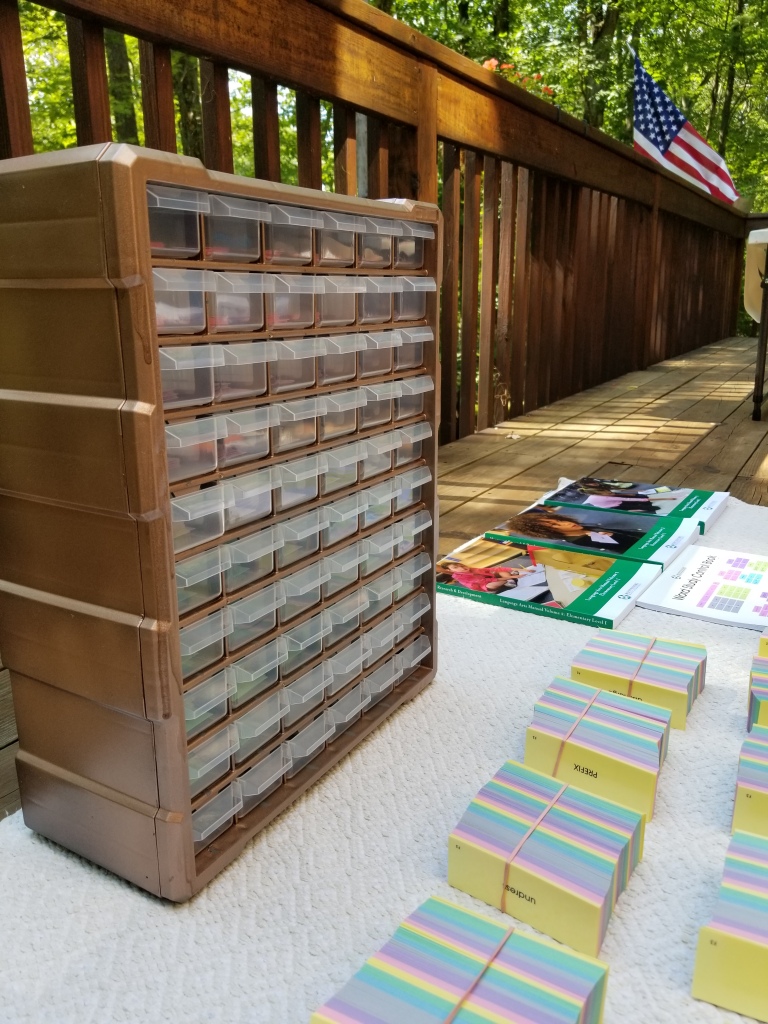Language Arts, 6-9

The Word Study from Montessori Research and Development is aligned with their manuals Language Arts Volume 2 and 3. This means, you will find the sequence and presentations for this material in the manuals. Every chapter in the manuals covers one specific topic (ex: compound words), and describes the materials needed, offers a scripted presentation, states the aim of the presentation and the age group, and much more.
Materials
Word Study Complete Set from Montessori Research and Development consists of 4 different sets that can be purchased separately or together. I will demonstrate set #1 out of 4 in this post, but will also mention the content of all 4 sets as they are complementary. The complete 4 sets contain:
- Set #1 – 900+ cards (compound words, suffixes, prefixes)
- Set #2 – 1700+ cards (antonyms, synonyms, homophones, homographs)
- Set #3 – 1100+ cards (capital letters, period, comma, apostrophe, quotation marks)
- Set #4 – 1100+ cards (classification, alphabetical order, dictionary usage, Thesaurus)
- a thick Word Study Book Control
- 4 laminated charts with texts for activities
- Instructions on how to organize the cards in suggested containers.


How to store the cards
Montessori Research and Development suggests purchasing 1 large 60 drawers container per set. Below is a picture of the box they suggested from a hardware store. You will need 4 containers to create a “Skyscraper,” a tall tower of 4 containers stacked. You will organize the cards using the letter-number codes (A1), and the colors (pastel pink). For example, first drawer contains Pink A1, the next drawer Pink A2, etc… Montessori RD sets include additional blank cards in case of a missing or lost card. I used those extra cards and a Sharpie to create labels for the drawers, and used a glue gun to secure them.


How it works
My 9 year old has been excited to use this set, as she remembers receiving some of the Key Experiences in the past. I illustrated one the Key Experiences on Compound Words to share with you.
- First, the child is provided with a Student Record Sheet for tracking work, and a notebook. The child will then copy this lesson in their notebook. We personally use a sheet of paper and a binder.

- Using the manuals, you will have practiced presenting the “Key Experiences” prior to the presentation. The presentations are so well described, there will be no confusion. You will see the child enjoying the presentation and connecting the dots! This experience should stay with the child when working with the activities using the cards. See the “Key Experience” below for Compound Words using a wheel and a pin to demonstrate how 2 root words form a compound word: pinwheel.

Manuals to present the materials 
Sample lesson on Compound Words 
Key Experience lesson on Compound Words
- After this, the child is ready for practicing the component you have taught through the “Key Experience.” You can help with the first drawer that corresponds to what you have presented. Now the child is ready to work independently. He may select the drawers in order as they increase in complexity. There will be different activities for him to do. He might need a little guidance as the tasks might change. For example, one activity on suffixes might be to combine roots and suffixes [astronom er], and another activity might be to copy on a notebook the roots and suffixes separately [astronomer].

Title Label for lesson 
Connecting Compound Words 
Ready to copy work 
Comparing work with control book
- Once the work is done, the cards are organized, the work is copied, then the child can check his work on the Study Word Control Book (see picture below). The Control Book is extremely well organized, detailed, and sturdy. For classroom use, I would recommend you make a copy and preserve your own book.

As the child progresses through this work, they will encounter many English language components, which I listed below in the order they are offered in the sets:
- Compound Words
- Suffixes
- Prefixes
- Antonyms
- Synonyms
- Homophones
- Homonyms
- Homographs
- Capital Letters
- Abbreviations
- Sentences and Phrases
- Apostrophes
- Possessives
- Commas
- Quotation Marks
- Classification
- Alphabetical Order
- Guide Words
- Dictionary Usage
- Thesaurus
When practicing with this material, a child should have a well rounded knowledge of the different mechanics of the English language. Each language component is incrementally structured, and keeps the child engaged. The copy work allows the child to practice order, and spelling on a variety of vocabulary. I hope you enjoyed this post! Leave a comment if you have questions that remained unanswered.





This experience was made possible by Montessori Research and Development that offered me the Word Study set at no cost, with no obligation. This set is a classic in Montessori classrooms, as it has been around for decades!


Ready for a lesson? Don’t miss my next post on The Fundamentals Needs of Humans from Montessori Research and Development. Subscribe to receive notifications!


I’ve been following you on IG (love your content) but I’m a bit torn. You speak of Montessori RD and AllisonMontessori’s word study program. I have no idea wich one to choose. Are they both the same do they both provide the same content? I’m new to this and I’m nervous about making and expensive decision. Can you please give me some insight? Weseca has one too, this part is overwhelming.
LikeLike